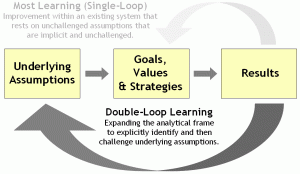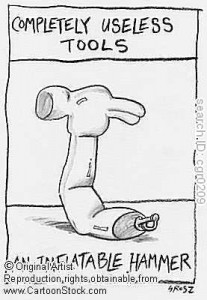Every organization has its culture that you can see when you observe people at their daily work. This observed culture should be aligned with, or congruent to, the official organizational culture. In reality there is often a gap between the intended culture and the real observed one. For example, management might say that quality is above everything else, while pushing to release new versions of low quality product riddled with defects. Or an organization touts its focus on learning and removing impediments, while the reality is the complete opposite. This post discusses the impact and importance of cultural alignment.
Management and leadership
A manager has in most cases two different roles or perspectives; they act both from a managment perspective and a leadership perspective. Depending on the organizational culture and personal preferences, the balance of these two may be quite different from person to person.
To clarify the difference between management and leadership, here are the definitions taken from management.about.com:
A Manager is the person responsible for planning and directing the work of a group of individuals, monitoring their work, and taking corrective action when necessary
Management is about commanding and controlling the behavior and tasks performed by the employees.
leadership is the art of motivating a group of people to act towards achieving a common goal
Compared to the management, perspective leadership is more about articulating a future goal and making that something that the organization and its employees strive to achieve together as a group.
As a manager you will always include both management and leadership perspectives in your daily work, but the leadership perspective has grown lately. We know today that we get more out of the organization if we trigger each person’s intrinsic motivation and creativity, and if we get everyone to collaborate to reach a common shared goal. This is in alignment with findings that Daniel Pink describes in his book Drive. He found that people are motivated by being autonomous, striving for a clear purpose and having the ability to work towards mastery. To enable this we need leaders who articulate the business and organizational goals and help the employees achieve their own self-improvement goals
Congruent leadership
But you need to do more than just articulating a vision and goal to be a good leader who motivates and brings out the creativity of the organization. You need to establish the boundaries and the constraints which the employees organize themselves around. The constraints give the employees a direction of the self-organization. Everybody needs to know which rules they need to follow, and what aspects of their work they may define and control by themselves. It is also very important that management’s actions are congruent to the spoken values and principles (definition copied from your dictionary).
Congruent describes something that agrees with or is in harmony with another
I know of organizations where you need to behave according to a specific manner; you are expected to act according to some cultural law. In these organizations this culture is often not explicit, it is something the employees need to find out by trial and error. The employees learn what they can say in public and what is regarded as against the cultural structure and value system by management interventions.
Incongruent actions impeding double-loop learnings
Establishing a learning organization seems to be a goal that is getting more attention nowadays. A lot of inspiration comes from Toyota and Lean, which essential is about continuously learning from the mistakes, finding the root cause and then eliminating it to improve the system. To be a learning organization all employees at all different positions and levels must be able to challenge all aspects of the organization. The goal is to continuously remove impediments and things that slow you down; no matter what you need to do to increase delivered value. In his book the Fifth Discipline, Peter Senge a learning organization as
organizations where people continually expand their capacity to create the results they truly desire, where new and expansive patterns of thinking are nurtured, where collective aspiration is set free, and where people are continually learning to see the whole together
Another way of describing a learning organization is an organization that is using double-loop learning to improve its behavior and processes.
In single-loop learning you observe your present situation and find problems and errors, then you adapt your actions to mitigate and improve the situation accordingly. The problem with single-loop learning is that you only remove the symptoms, the root cause is still present and will give you new problems in the future. Using double-loop learning you examine the underlying assumptions and search for the governing variables behind the actions and behavior, and change them instead. This will remove the root cause, the assumptions that makes us behave and act in a certain and costly way.
A lot of the governing variables are present in the value system that you have in the organization, and often these values are different compared to the ones you talk about and present as the core values. One such variable is the assumption around expected behavior by the employees at different levels of the organization. For example, management tells the employees to speak up regarding problems that they feel they have, but when they do so, the same management gives them negative feedback due to being whiny and not acting according to the cultural values. In this case we have an organization with a strategy that directs the employees to speak up, but also an underlying assumption where the employees are expected to act as a team player and not going against the management and established working practices. Incongruent actions like this will definitely impede the implementation of double-loop learning and stop the establishment of the learning organization.
An example from my past
I was a Scrum Master once for a team that had a problem with the tools they needed to use; some of the employees didn’t think that the tool was suited for the job we needed to do. This was a tool used by one group in the organization and there existed some assumptions behind the usage of the tool:
- The employees should use a really simple tool to not make the situation more complicated than necessary.
- They didn’t need a better tool since the code they’re supposed to write should be really simple; they didn’t need support for refactoring or unit testing due to the simplicity of the code base.
During the project, one of the team members, coming from a different part of the organization, complained about the tool. He thought the tool didn’t give him and the team the support they needed to craft good quality code. Instead of taking this as a learning opportunity to both see if we could improve the working conditions for the employees, and also discuss the underlying assumptions, the employee got a reprimand for not acting according to his seniority and not acting respectfuly towards his colleagues.
At the same time this was an organization striving to be lean and agile. The management talked a lot about reaching a state where we continuously improved the way we did product development. Apparently the organization and its leaders were not in congruence with the public values; the actions the management took in certain situations were not aligned to the core values the same management tried to establish. It is very demotivating for the employees to work under such conditions. An intrinsic motivator such as autonomy is very sensitive to incongruent situations where the public and described boundaries controlling self-organization are not the same as the real, experienced boundaries. If the managers encourage the employees to act on problems and speak up when they need help, and if they get negative feedback when they do so accordingly, the employee will lose trust in management. The emplyees will also filter what they say about their working conditions and experienced problems and impediments. The result will be quite different compared to a real learning organization, and the management will eventually lose touch with reallity and will not know or understand the real situation in the organization anymore. There is no double-loop learning, and in most cases, not even single-loop learning either.
Summary
So managers, how do you react if someone during a all hands meeting races her hand and says that a tool that she is using is totally useless and impossible to work with in order to produce their software? Will you think that she is complaining and then talk to her supervisor after the meeting to make sure she gets a reprimand, or will you think that she is taking the lead to make sure you have as efficient an environment as possible so that you can continuously increase the delivered value?
PS: If you would like to read more about congruent actions and leadership, please read Jerry Weinbergs book, “Quality Software Management, Congruent Action”. Weinbergs series about quality software management is highly recommended reading in general, but I regard this third volume to be the best in the series.






One response on “Congruent leadership”